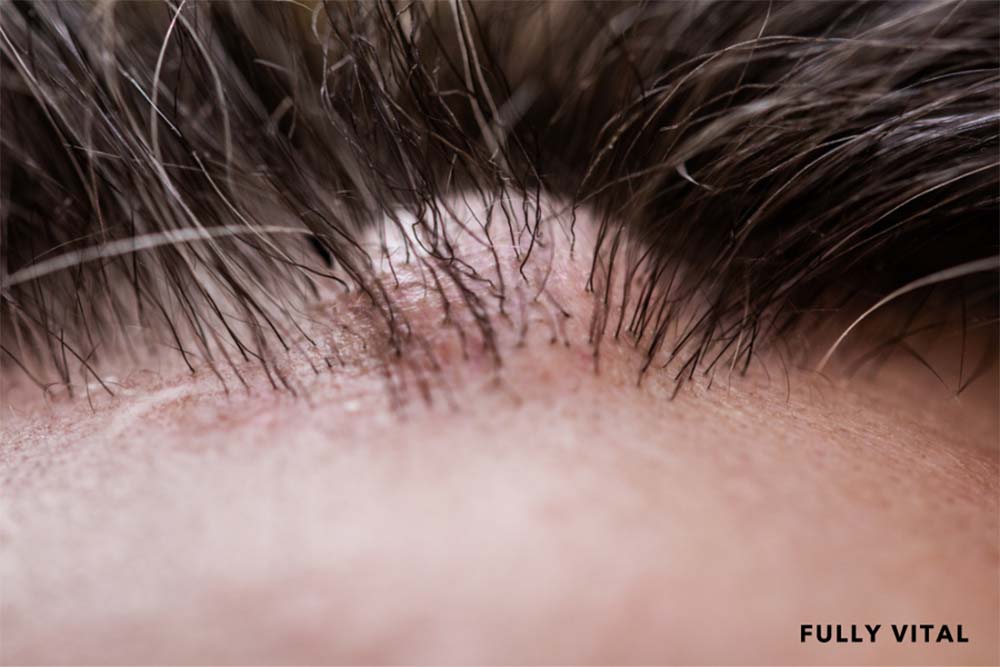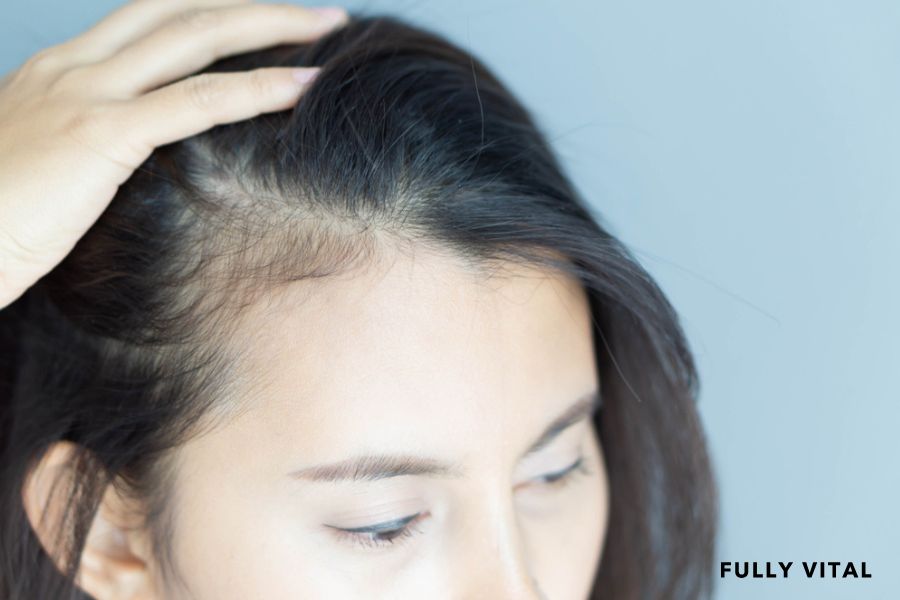
Unlocking The Secrets Of Pilar Cysts For Healthier Hair Growth
In our quest to provide women of all hair types with comprehensive information on stimulating hair growth.
We delve into the topic of pilar cysts.
These pesky cysts can often be overlooked, yet understanding and addressing them can be crucial for maintaining your hair's health.
Let's explore pilar cysts in detail to ensure you have all the facts you need.

I LOVE MY HAIR NOW
FullyVital hair serum and hair vitamins made tremendous improvements in my hair. I truly love my hair now.
Shop Hair ProductsWhat Is A Pilar Cyst?
Pilar cysts, also known as trichilemmal cysts, are small, benign growths that commonly appear on the scalp.
These cysts are usually round or oval in shape and are filled with a protein-rich, white, cheesy substance.
While pilar cysts are generally harmless, they can occasionally become inflamed or infected, causing discomfort.

Why Is Understanding Pilar Cyst Important?
Understanding pilar cysts is essential for anyone seeking to promote healthy hair growth.
These cysts can sometimes obstruct hair follicles, potentially leading to hair thinning or hair loss.
By knowing how pilar cysts occur and addressing them effectively, you can prevent these issues and enjoy luscious locks.
How Does Pilar Cyst Develop?
Pilar cysts develop from hair follicles when the cells lining the follicle wall multiply excessively.
This overproduction of cells forms a sac, trapping keratin and creating a cyst.
The exact cause of this cell overgrowth is still under investigation, but genetics and trauma to the hair follicle may play a role.1
What Are The Benefits Of Addressing Pilar Cyst?
Addressing pilar cysts offers several advantages for your hair health:
Preventing Hair Thinning
By removing or treating pilar cysts, you can prevent potential blockages of hair follicles, reducing the risk of hair thinning.
Enhancing Hair Growth
Healthy hair follicles contribute to more robust hair growth, resulting in thicker and fuller locks.2
Reducing Discomfort
Pilar cysts can become painful if they become inflamed or infected.
Addressing them can alleviate discomfort.
Are There Any Downsides To Pilar Cyst?
While pilar cysts are typically harmless, there can be downsides to neglecting them:
- Hair Thinning: Untreated cysts can lead to hair follicle blockage and subsequent hair thinning.
- Discomfort: Inflamed or infected cysts can cause pain and discomfort.
What Are The Alternatives To Pilar Cyst Treatment?
If you're considering addressing pilar cysts, there are several treatment options available:
- Surgical Removal: Your dermatologist can surgically remove the cyst, ensuring it doesn't recur.
- Laser Therapy: Laser therapy is a non-invasive option for removing pilar cysts.
- Topical Treatments: Some topical treatments may help reduce the size of the cyst or alleviate discomfort.
What Is Inside A Pilar Cyst?
Pilar cysts, also known as trichilemmal cysts, contain specific elements that define their characteristics.
Inside a pilar cyst, you'll find:
Keratin
The cyst is primarily filled with keratin, a fibrous protein that makes up hair, nails, and the outer layer of the skin.
The keratin within the cyst often takes on a thick, cheesy consistency.
Epithelial Cells
The cyst develops from the hair follicle's epithelial cells.
These cells multiply excessively, forming a sac that traps the keratin, resulting in the cyst.
Does Hair Grow On Pilar Cysts?
Hair can sometimes grow on or around pilar cysts, but it's essential to note that the cyst itself doesn't produce hair.
The presence of hair around the cyst is due to its location on the scalp, where hair follicles are abundant.
However, if left untreated and the cyst continues to grow, it may hinder nearby hair growth.
Do Pilar Cysts Cause Hair Loss?
Pilar cysts themselves do not directly cause hair loss.
However, if a cyst becomes large enough or gets infected, it can obstruct hair follicles and potentially lead to hair thinning or hair loss in the surrounding area.
Addressing pilar cysts in their early stages can help prevent this issue.
How Long Is Recovery From Pilar Cyst?
The recovery time from pilar cyst treatment can vary depending on the chosen method:
- Surgical Removal: If you opt for surgical removal, you can typically expect a recovery period of a few days to a week. You may experience some discomfort, but it should gradually improve.
- Laser Therapy: Laser therapy is less invasive and may have a shorter recovery time, often a few days.
- Topical Treatments: If you're using topical treatments, recovery is generally minimal, and you can resume your regular activities almost immediately.
Your dermatologist will provide you with specific post-treatment care instructions to ensure a smooth recovery.
How Do You Treat A Pilar Cyst At Home?
While it's essential to consult a dermatologist for proper treatment, there are a few home care tips you can consider if you suspect you have a pilar cyst:
- Keep it Clean: Gently clean the cyst with mild soap and warm water. Avoid excessive scrubbing, as it may irritate the area.
- Avoid Squeezing: Do not attempt to squeeze or pop the cyst at home, as this can lead to infection and scarring.
- Warm Compress: Applying a warm, moist compress to the cyst may help reduce discomfort and inflammation.
- Over-the-Counter Pain Relief: Over-the-counter pain relievers may alleviate any pain associated with the cyst.
Remember that while these home care measures may offer temporary relief, they are not a substitute for professional treatment.
It's essential to consult with a dermatologist to determine the most appropriate course of action for your pilar cyst.
What Is The History Of Pilar Cysts?
Ancient Anecdote
Pilar cysts have been documented throughout history, with references dating back to ancient civilizations.
The knowledge of these cysts has evolved over time, offering a fascinating glimpse into the historical understanding of scalp health.
Medical Advancements
In more recent history, medical science has made significant strides in diagnosing and treating pilar cysts.
The development of surgical techniques and non-invasive procedures has improved patient outcomes and comfort.
Research and Discovery
Ongoing research into the causes and treatments of pilar cysts continues to expand our understanding of these growths.
This historical perspective helps us appreciate the progress made and the potential for further advancements in hair health.
What Is The Current Environment Of Pilar Cysts?
Prevalence and Diagnosis
Pilar cysts remain a common occurrence, with individuals seeking medical advice for diagnosis and treatment.
Dermatologists and healthcare professionals play a crucial role in addressing these cysts in the current medical landscape.
Treatment Options
Today, individuals have a range of treatment options for pilar cysts, from surgical removal to less invasive methods like laser therapy.
The availability of these options ensures that patients can choose what suits them best.
Patient Awareness
increased awareness of pilar cysts and their potential impact on hair health has led to proactive seeking of medical advice.
This awareness contributes to earlier diagnosis and treatment, potentially minimizing hair-related issues.
What Is The Future Of Pilar Cysts?
Advancements in Treatment
As medical research and technology continue to advance, we can anticipate more effective and less invasive treatments for pilar cysts.
These innovations will enhance patient comfort and outcomes.
Preventive Measures
The future may bring new insights into preventing the development of pilar cysts altogether.
Understanding the underlying causes and risk factors could lead to proactive measures for maintaining scalp health.3
Integration with Hair Growth Solutions
Pilar cysts will likely continue to be an important topic for Hair Growth Product Companies, as the connection between scalp health and hair growth becomes more apparent.
Future products may incorporate solutions that address both issues simultaneously, providing holistic care for individuals seeking vibrant hair.
Unlock The Power Of Youthful Hair With Fully VitalExperience the transformation your locks deserve with Fully Vital's science-backed hair growth products:
Unlock your hair's true potential with Fully Vital - your partner in the journey to vibrant, age-defying hair. |
Final Thoughts On Pilar Cyst
Gaining insights into the world of pilar cysts is a crucial step in your quest for healthier and more luscious hair.
We've explored the history, current landscape, and future prospects of pilar cysts, shedding light on their significance in the realm of hair health.
As you embark on your journey to healthier hair, remember that understanding and addressing pilar cysts can be a pivotal part of the process.
To fully unlock the potential of your locks, consider exploring the comprehensive range of hair growth products offered by Fully Vital.
Our products are specially designed to combat the signs of aging and promote vibrant, resilient hair.
Take the next step in your hair care journey and make the most of your locks with Fully Vital's trusted solutions.
Your path to healthier, more beautiful hair awaits.
Frequently Asked Questions About Pilar Cyst
Do pilar cysts always require treatment?
Not necessarily.
Pilar cysts that are small, asymptomatic, and not causing hair thinning or discomfort may be left untreated.
However, if they grow, become painful, or pose cosmetic concerns, it's advisable to seek professional evaluation and consider treatment options.
How can I tell if I have a pilar cyst?
Pilar cysts typically feel like small, round bumps on the scalp.
If you notice one, it's best to consult a dermatologist for a proper diagnosis.
Can pilar cysts be prevented?
While the exact cause of pilar cysts is not always clear, there are no guaranteed prevention methods.
However, maintaining a healthy scalp and hair care routine may help.
Can pilar cysts develop anywhere on the body?
Pilar cysts most commonly occur on the scalp, but they can potentially develop anywhere with hair follicles.
However, their occurrence outside the scalp is relatively rare.
Are pilar cysts contagious or hereditary?
No, pilar cysts are neither contagious nor strictly hereditary.
While there may be a genetic predisposition to developing them, they are not directly passed from one person to another.
Can you prevent pilar cysts from developing?
Preventing pilar cysts entirely may not be possible due to genetic factors, but you can take steps to minimize the risk:
-
Maintain Good Scalp Hygiene: Regularly wash and care for your scalp to reduce the likelihood of cyst formation.
-
Avoid Trauma: Protect your scalp from injuries or traumas that could potentially trigger cyst development.
Can pilar cysts recur after treatment?
Yes, pilar cysts can sometimes recur even after treatment.
This recurrence may happen if the entire cyst sac is not removed during surgery or if new cysts form in the same area.
Regular follow-ups with your dermatologist can help address any potential recurrences promptly.
Can I pop a pilar cyst myself?
We strongly discourage attempting to pop or remove a pilar cyst yourself.
Self-removal can lead to infection, scarring, and complications.
It's safer and more effective to consult with a healthcare professional for proper diagnosis and treatment.
Are pilar cysts painful?
Pilar cysts are generally not painful.
However, if a cyst becomes inflamed, infected, or presses on surrounding tissue, it can cause discomfort or pain.
If you experience pain or discomfort, consult a healthcare professional for evaluation and appropriate treatment
How can I tell if my pilar cyst is infected?
An infected pilar cyst may exhibit symptoms such as increased pain, redness, warmth, and pus discharge.
If you suspect your cyst is infected, seek medical attention promptly.
Sources
- Al Aboud, D. M., Yarrarapu, S. N. S., & Patel, B. C. (2022). Pilar Cyst. PubMed; StatPearls Publishing. https://www.ncbi.nlm.nih.gov/books/NBK534209
- Hoover, E., Alhajj, M., & Flores, J. L. (2020). Physiology, Hair. PubMed; StatPearls Publishing. https://www.ncbi.nlm.nih.gov/books/NBK499948
- Varghese, R., Yabit, F., Alrifai, A., Burns, A., Boucher, B., & Tiesenga, F. (2022). Pilar Cysts of the Head and Neck: A Case Report. Cureus. https://doi.org/10.7759/cureus.23932








